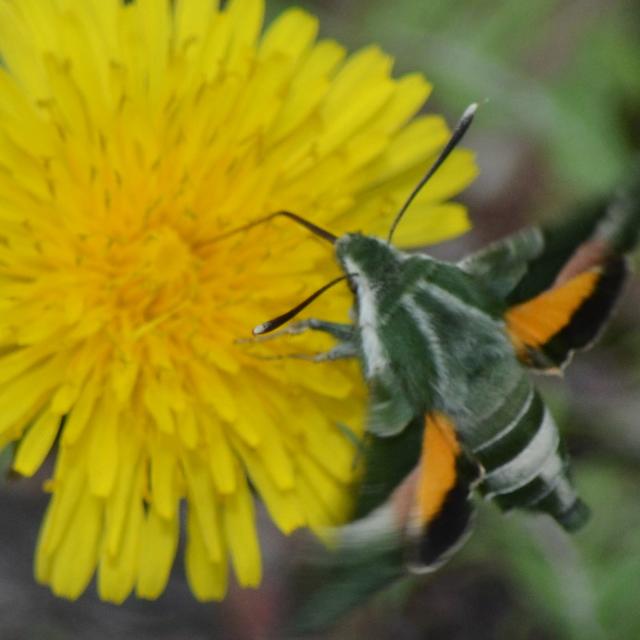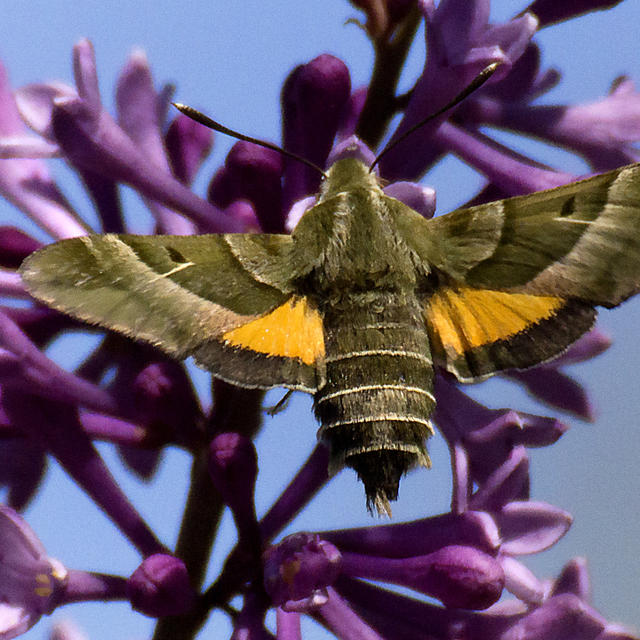Clark's sphinx
Proserpinus clarkiae (Boisduval, 1852)
Family: Sphingidae
Subfamily: Macroglossinae
Identification: Forewing upperside is greenish gray; median area may be dark or pale. Hindwing upperside is bright orangish yellow with black borders.
Wing Span: 1 3/8 - 1 3/4 inches (3 - 3.8 cm).
Life History: Eggs hatch about 10 days after the female deposits them on the host plant, and the newly-hatched caterpillars eat their eggshells. Fully-grown caterpillars pupate and overwinter in burrows dug under stones and other solid objects. Adults fly during the day, especially in the afternoon.
Flight: . One brood from April-June.
Caterpillar Hosts: Elegant fairyfan (Clarkia unguiculata) in the evening primrose family (Onagraceae).
Adult Food: Nectar from flowers including chia (Salvia columbariae), heartleaf milkweed (Asclepias cordifolia), golden currant (Ribes aureum), bluedicks (Dichelostemma capitatum), fairyfans (Clarkia), vetches (Vicia), thistles (Cirsium), and hedgenettles (Stachys).
Habitat: Oak woodland and pine-oak woodland in foothills.
Range: British Columbia and Washington south through California to Baja California Norte, east to Idaho, Wyoming, and Utah.
Conservation: Not usually required.
NCGR: G5 - Demonstrably secure globally, though it may be quite rare in parts of its range, especially at the periphery.
Management Needs: None reported.
Comments: NULL
Please donate!
We depend on donations to keep Butterflies and Moths of North America freely available. We want to express our gratitude to all who showed their support by making a contribution this year. You can donate to support this project at any time.
Advertise with us!
Do you have a product or service that you think would interest BAMONA users? If you would like to advertise on this website, contact us by email, or use the contact form and select the "Advertising" category.
Verified Sightings
Displaying 1 - 24 of 104 verified sightings

Observation date: Jun 09, 2024
Submitted by: weflybye
Region: Mason County, Washington, United States
Verified by: davidwdroppers
Verified date: Jun 09, 2024

Observation date: Apr 11, 2015
Submitted by: enabreu
Region: San Mateo County, California, United States
Verified by: curtis.lehman
Verified date: Mar 19, 2024

Observation date: Jun 01, 2021
Submitted by: wildebynature
Region: British Columbia, Canada
Verified by: davidwdroppers
Verified date: Sep 16, 2022

Observation date: Jun 02, 2021
Submitted by: wildebynature
Region: British Columbia, Canada
Verified by: Paul Prappas
Verified date: Sep 10, 2022

Observation date: Jun 27, 2022
Submitted by: Jehlers86
Region: Park County, Wyoming, United States
Verified by: J_Martineau
Verified date: Jun 30, 2022

Observation date: Mar 20, 2022
Submitted by: EdVermeulen
Region: Sonoma County, California, United States
Verified by: mcduck
Verified date: May 30, 2022

Observation date: May 03, 2018
Submitted by: Kristie Nelson
Region: Mono County, California, United States
Verified by: ishaan2009
Verified date: Dec 06, 2021

Observation date: May 29, 2020
Submitted by: GaryMerrill
Region: Tehama County, California, United States
Verified by: mcduck
Verified date: Oct 24, 2021

Observation date: Jun 29, 2018
Submitted by: Scott Burgess
Region: Humboldt County, California, United States
Verified by: ishaan2009
Verified date: Oct 16, 2021

Observation date: Jun 21, 2020
Submitted by: Natural DeBee
Region: Klamath County, Oregon, United States
Verified by: J_Martineau
Verified date: Feb 24, 2021

Observation date: May 21, 2020
Submitted by: bobscafe
Region: British Columbia, Canada
Verified by: davidwdroppers
Verified date: May 23, 2020

Observation date: May 19, 2020
Submitted by: Dwaine Wagoner
Region: Natrona County, Wyoming, United States
Verified by: J_Martineau
Verified date: May 20, 2020

Observation date: May 21, 2018
Submitted by: bobscafe
Region: British Columbia, Canada
Verified by: davidwdroppers
Verified date: May 22, 2018

Observation date: Jun 05, 2016
Submitted by: shastamax
Region: Siskiyou County, California, United States
Verified by: Josiah Gilbert
Verified date: Jun 07, 2017

Observation date: Jun 02, 2017
Submitted by: shastamax
Region: Siskiyou County, California, United States
Verified by: Josiah Gilbert
Verified date: Jun 06, 2017

Observation date: May 13, 2014
Submitted by: Josiah Gilbert
Region: San Luis Obispo County, California, United States
Verified by: Josiah Gilbert
Verified date: May 25, 2015

Observation date: May 13, 2013
Submitted by: MTmariposa
Region: Missoula County, Montana, United States
Verified by: davidwdroppers
Verified date: May 20, 2015

Observation date: Mar 25, 2015
Submitted by: melina staal
Region: Mariposa County, California, United States
Verified by: Josiah Gilbert
Verified date: Mar 26, 2015

Observation date: May 15, 2014
Submitted by: Mark W. Stockslager
Region: Jackson County, Oregon, United States
Verified by: Robert Martin
Verified date: May 26, 2014

Observation date: Jun 08, 2013
Submitted by: HHowell
Region: Teton County, Wyoming, United States
Verified by: J_Martineau
Verified date: Jul 10, 2013

Observation date: Jun 16, 2013
Submitted by: gilde
Region: Union County, Oregon, United States
Verified by: kellyrichers
Verified date: Jul 09, 2013

Observation date: Jun 08, 2008
Submitted by: plex1ppus (plex1ppus)
Region: Whitman County, Washington, United States
Verified by: davidwdroppers
Verified date: Apr 13, 2011

Observation date: unknown
Submitted by: BAMONA
Region:
Verified by: BAMONA
Verified date: Sep 06, 2010
Observation date: Mar 14, 2007
Submitted by: legacy.reporter (Paul Johnson)
Region: San Benito County, California, United States
Verified by: paulopler (Paul Opler)
Verified date: Mar 21, 2007
- 1 of 5
- next ›


